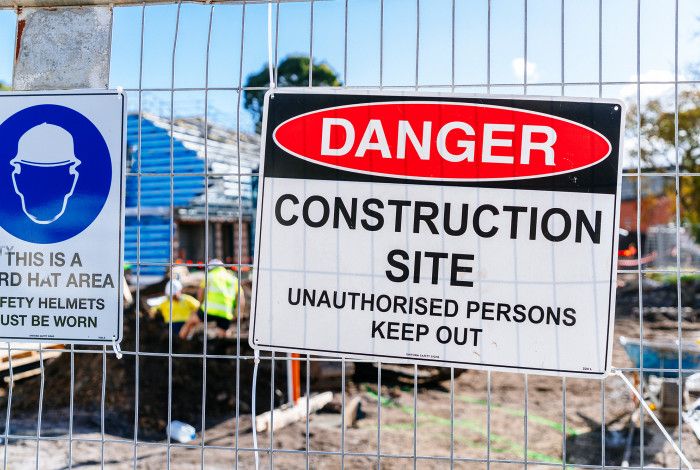The purpose of the Asset Protection Permit (APP) is to ensure that public assets and infrastructure (e.g. footpaths, drains, roads, laneways etc) are kept safe, maintained in a serviceable condition and damages repaired at the completion of the building/demolition works.
Under the APP the applicant shall be held liable for any damages caused by the building/demolition works.
Under Council's Local Law No. 2 Clause 23 - Building Works, a fine of up to $1,250 may apply if you commence work without a valid Asset Protection Permit.
There are set fees and security bonds which will apply to the Asset Protection Permit. The general fees are listed below.
When is an Asset Protection Permit required?
An asset protection permit is required when undertaking construction, renovation, alteration, relocation etc:
- Building works where the cost exceeds $10,000
- Swimming pools, spas and water features where the cost exceeds $5,000
- Any building demolition work
- Earthworks - Planning Permit Work
- Front fencing with continuous concrete strip footing, brick or masonry fencing
How to apply for a permit
From Monday 1 July 2024, Asset Protection Permit Applications will need to be submitted via an Online Portal.
Council will no longer be accepting paper or email copies of the application form.
Download the User Guide - 734.6KB
Permit application instructions:
- Council reserves the right to cancel an application if the correct fee(s) and/or bond(s) have not been received. The applicant will be contacted directly by Council if this is the case following the review of their application.
- The permit is valid for 24 months from the date Council issues it.
- If you do not get a permit, Council can fine you up to $1,250.
- Builder and/or Demolisher must have min $10 million public liability insurance.
- The applicant can be the property owner, builder or demolisher.
- A pre-commencement report is not required as Council will conduct an inspection prior to and after completed works.
Asset Protection Permit Fees
Please note: Where demolition and construction are applied for in one application, two fees and only one bond (the larger of the two) will apply.
How long does it take to obtain a Permit?
The permit will be issued within ten working days, subject to receipt of all required information and payment. The permit is valid for the specified period of 24 months from the date of permit being issued, unless renewal or extension.
Damage to Council Asset - Repair Options
The applicant may choose to carry out rectification works for the damage identified through the Asset Protection Permit final inspection. Discuss this option with Council's inspector, prior to undertaking any works as you may be required obtain other relevant permits.
For more information visit the Civil Works Permit web page.
Alternatively, you can request for Council to undertake the rectification works on your behalf. The costs of these repairs will be deducted from the bond and the remainder refunded to the applicant accordingly. If the rectification costs exceed the bond amount, Council will cover the excess and invoice you to recover the additional amount.
Security and Final Inspection Request
What is a security bond?
A security bond is required to cover any potential costs associated with damages to Council infrastructure as a direct result of your works.
How do I reclaim my security bond?
The process to return the security bond is initiated by requesting a final inspection of the completed works
To book a final inspection by emailing the following documents to assetprotection@cgd.vic.gov.au
- Completed Final Inspection Request form - Complete the Final Inspection Request Form - 176KB
- Provide additional documentation
If you paid before 19 January 2024 via credit card, or at any time with cash or cheque:
This process also applies to you, if the credit card used for the original bond payment has since expired.
Proof of Payment – e.g. a bank or credit card statement showing:
- The bond payment transaction
- The bank account name and details of the person or company who made the payment
If you paid on or after 19 January 2024 via credit card through our website and your credit card has not expired:
No additional documentation is required. The bond will be automatically refunded to the credit card used for the original payment
Allow up to 5 business days for an inspection to occur.
On completion of the inspection and if Council’s authorised officer is satisfied that:
- No damage has been caused, or
- Damage has been repaired to Council’s standards and/or specifications.
A letter of release will be sent to the permit holder and the bond will be returned accordingly.
How do I renew or extend my Permit?
You do not need to complete another application form. Council will send you a letter advising that works should not continue without the valid Asset Protection Permit.
If your works need to be extended or renewed, you need to:
Send email to assetprotection@cgd.vic.gov.au quoting your Asset Protection Permit application number and address
Note: If you have applied for a demolition permit only, and plan to proceed with construction now, please also provide:
• Builder’s contact details
• Public Liability Insurance information
• Scope of works (e.g. single dwelling, multi-unit including unit numbers)Once the invoice is issued, you will need to pay applicable renewal fee via cheque, over the phone, online or in person
Council will then issue a renewal permit, via email or post (if email is not provided)





